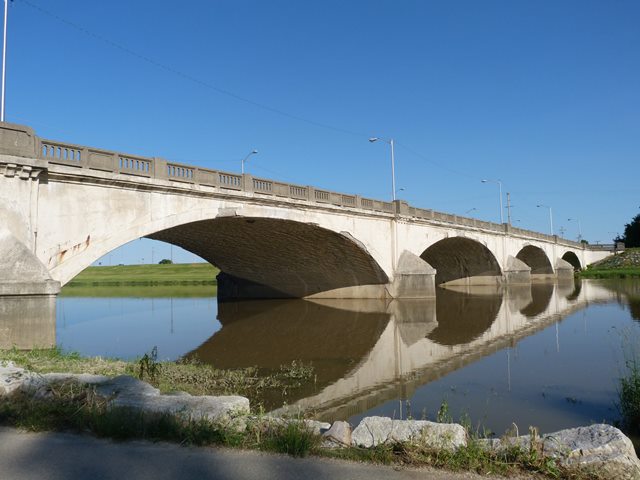We Recommend:
Bach Steel - Experts at historic truss bridge restoration.
BridgeHunter.com Phase 1 is released to the public! - Visit Now
Keowee Street Bridge

Primary Photographer(s): Nathan Holth and Rick McOmber
Bridge Documented: June 6, 2014
Dayton: Montgomery County, Ohio: United States
1931 By Builder/Contractor: Maxon Construction Company of Dayton, Ohio
Not Available or Not Applicable
97.0 Feet (29.6 Meters)
516.0 Feet (157.3 Meters)
40 Feet (12.19 Meters)
5 Main Span(s)
5760550

View Information About HSR Ratings
Bridge Documentation
This bridge no longer exists!
Bridge Status: Demolished in 2018 as part of replacement project.View Archived National Bridge Inventory Report - Has Additional Details and Evaluation
This bridge is noted for its lack of alteration and decent size, composed of five spans. The bridge retains attractive concrete railings of an interesting design.
The contractor for this bridge, Maxon Construction Company of Dayton, Ohio, is assumed to be related to Wiley-Maxon Construction Company of Dayton, Ohio which was the builder of the Columbia-Wrightsville Bridge in Pennsylvania.
Dayton at one time had an impressive collection of concrete arch bridges, one of the finest in Ohio. In 2006, HistoricBridges.org made a bad decision to bypass Dayton's bridges in favor of bridges elsewhere in the region. Since that time, Dayton has demolished half of its historic concrete arch bridges. As of 2015, the remaining three face a future that is no brighter.
Watch out for Red Light and Speed Cameras if you visit this bridge! One was observed on this street!
Information and Findings From Ohio's Historic Bridge InventorySetting/Context The bridge carries a 4 lane street and sidewalks over the Great Miami River in Dayton. Physical Description The 5 span, 490'-long, reinforced-concrete arch bridge has concrete balustrades that have panels alternating between open balusters and solid incised-panels. The spandrel walls are paneled as are the pilasters over the bullnose piers. There are shadow lines accenting the arches. Integrity Some loss of original fabric from spalling. Summary of Significance The 1931 deck arch bridge is a late but complete multiple-span example of its type/design with typical detailing. There are no innovative or distinctive details, and although it is multiple span, there are numerous earlier and better detailed examples in the county and region. The bridge is not historically or technologically significant. The 2007-08 ODOT Historic Bridge Inventory Update (Phase 1A) has identified more than 225 extant, reinforced-concrete, closed-spandrel arch bridges dating from 1896 to 1959. Fewer than 30 examples date to before 1910. Those tend to represent innovative technology or early attempts at exploring the aesthetic qualities of the moldable material; earlier examples tend to have higher historical and technological significance than the later examples. Use of the reinforced-concrete, closed-spandrel arch technology reached its height during the 1910s and 1920s with more than 80% of Ohio's surviving examples dating from those two decades. The later examples generally do not represent innovative technology, although they sometimes have high aesthetic merit or significant settings/contexts. "Closed spandrel arch bridges are the most basic of reinforced concrete bridge types. Closed spandrel means that the area between the deck and the arch ring was filled in. The spandrel wall actually serves as a retaining wall in the bridge, holding the fill material. Live loads are borne by the fill material and by the spandrel walls. The arch may be constructed either as a single structural element (barrel) or in separate parallel longitudinal ribs. The barrel arch design has some structural and visual similarities to stone arch bridges. The barrel arch is also sometimes faced with brick or stone, making it appear similar to a masonry arch bridge. This type of bridge is suitable for short span lengths. Closed spandrel concrete arches predate open spandrels, as the closed spandrel type harkens back to the stone arches that the earliest forms imitated. This type was not built for long as engineers realized that significant material could be saved and a reduction in weight could be achieved by eliminating the filled section. Hence, open spandrels were born. Filled spandrel concrete arches date primarily from the earliest decades of reinforced concrete (1890s through 1920s). They are not as common as many of the standardized bridge types built during this same era, such as concrete slabs and girders. They are significant because they are not common and represent the evolution of concrete technology. To be considered significant, filled spandrel arches should have integrity, through the retention of their character-defining features: arch ring, barrel, spandrel wall, railing or parapet, end posts, piers and/or abutments and wingwalls." [From: A Context for Common Historic Bridge Types by Parsons Brinckerhoff, October 2005] Bridge Considered Historic By Survey: No |
![]()
Photo Galleries and Videos: Keowee Street Bridge
Bridge Photo-Documentation
Original / Full Size PhotosA collection of overview and detail photos. This gallery offers photos in the highest available resolution and file size in a touch-friendly popup viewer.
Alternatively, Browse Without Using Viewer
![]()
Bridge Photo-Documentation
Mobile Optimized PhotosA collection of overview and detail photos. This gallery features data-friendly, fast-loading photos in a touch-friendly popup viewer.
Alternatively, Browse Without Using Viewer
![]()
Maps and Links: Keowee Street Bridge
This historic bridge has been demolished. This map is shown for reference purposes only.
Watch out for Red Light and Speed Cameras if you visit this bridge! One was observed on this street!
Coordinates (Latitude, Longitude):
Search For Additional Bridge Listings:
Bridgehunter.com: View listed bridges within 0.5 miles (0.8 kilometers) of this bridge.
Bridgehunter.com: View listed bridges within 10 miles (16 kilometers) of this bridge.
Additional Maps:
Google Streetview (If Available)
GeoHack (Additional Links and Coordinates)
Apple Maps (Via DuckDuckGo Search)
Apple Maps (Apple devices only)
Android: Open Location In Your Map or GPS App
Flickr Gallery (Find Nearby Photos)
Wikimedia Commons (Find Nearby Photos)
Directions Via Sygic For Android
Directions Via Sygic For iOS and Android Dolphin Browser
USGS National Map (United States Only)
Historical USGS Topo Maps (United States Only)
Historic Aerials (United States Only)
CalTopo Maps (United States Only)

